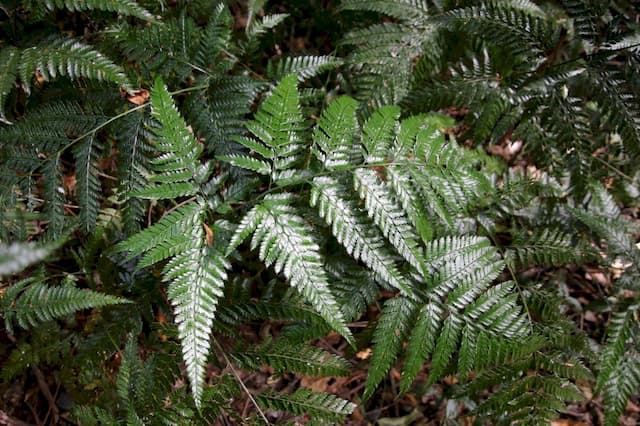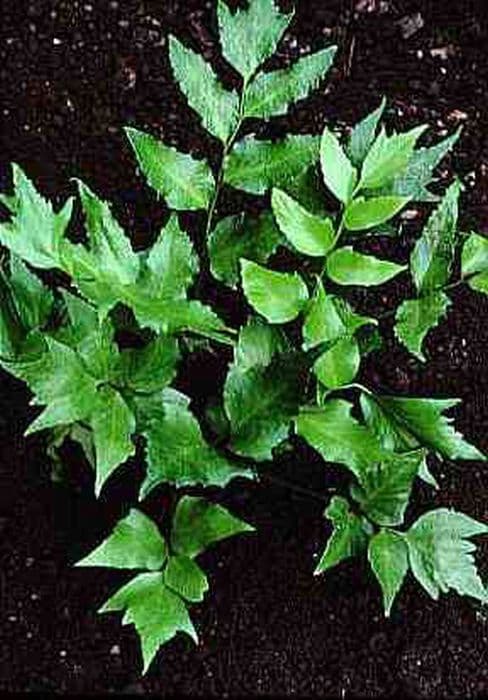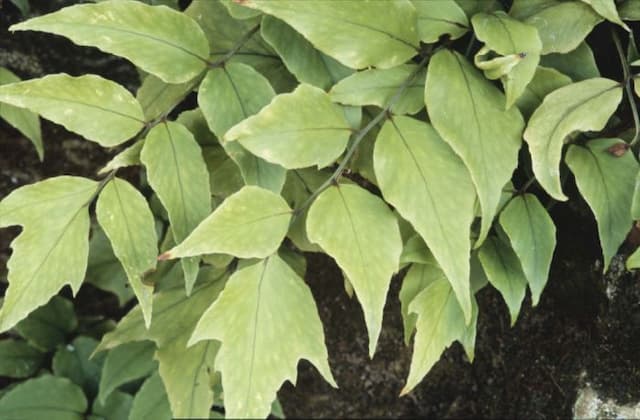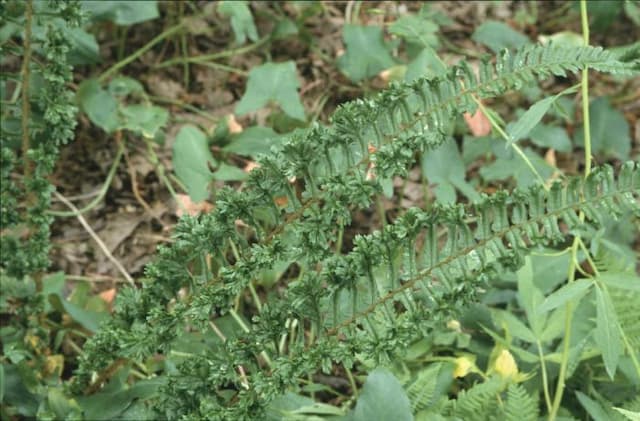Arachniodes simplicior

ABOUT
The Arachniodes simplicior, commonly known as East Indian Holly Fern, is a lush evergreen fern that is characterized by its shiny, leathery leaves which are often referred to as fronds. The fronds are intricately structured and display a beautiful dark green hue that can add a sense of vibrancy to any shaded garden space or indoor area. The leaves are typically divided into smaller sections called leaflets, which are arranged on each side of a central stalk, giving the entire frond a feather-like appearance. The edges of these leaflets are slightly toothed, and though they may look delicate, they are quite rigid to the touch. The central stalk, or stem, of each frond is often a paler green or may even have a slight golden or brownish tint, adding a subtle contrast to the deep green of the leaflets. Adding to its ornamental appeal, the East Indian Holly Fern has a graceful, arching growth habit that allows the fronds to cascade slightly. This fern's overall texture is smooth, and its form is dense, creating an appearance of fullness and lushness. In terms of its reproductive features, like other ferns, it does not flower but rather reproduces through spores, which are typically found on the undersides of the leaflets in small, dot-like clusters. The aesthetic appeal of the East Indian Holly Fern lies in its simplicity and the elegance of its foliage, which can serve as a cool, green backdrop in mixed plantings or as a standalone specimen that brings a touch of the forest to the environment it is placed in.
About this plant
 Names
NamesFamily
Dryopteridaceae
Synonyms
East Indian Holly Fern, Variegated Holly Fern
Common names
Arachniodes simplicior var. simplicior, Arachnoides aristata, Aspidium aristatum, Aspidium aristatum var. simplicior, Aspidium simplicior, Dryopteris aristata, Lastrea aristata, Lunathyrium aristatum, Nephrodium aristatum, Polystichum aristatum.
 Toxicity
ToxicityTo humans
The plant Arachniodes simplicior, commonly known as East Indian Holly Fern, is not generally considered toxic to humans. There are no well-documented cases or significant concerns regarding its toxicity for human ingestion. As with many plants, individual sensitivities could potentially occur, but these are not commonly reported or recognized for this particular fern species.
To pets
East Indian Holly Fern (Arachniodes simplicior) is not commonly known to be toxic to pets either. It is not listed among plants that are known to cause adverse effects in common household pets such as cats and dogs if ingested. However, to be cautious, it is still advised to prevent pets from ingesting plants, as individual reactions can vary and some plants may cause irritation or gastrointestinal discomfort even if they are not widely recognized as toxic.
 Characteristics
CharacteristicsLife cycle
Perennials
Foliage type
Evergreen
Color of leaves
Green
Height
3 feet [0.91 meters]
Spread
2 feet 6 inches [0.76 meters]
Plant type
Fern
Hardiness zones
9
Native area
East Asia
Benefits
 General Benefits
General Benefits- Ornamental Appeal: Arachniodes simplicior, commonly known as East Indian Holly Fern, adds aesthetic value to gardens with its shiny, dark green fronds that have a holly-like appearance.
- Shade Tolerance: It thrives in shaded areas where other plants might struggle, making it ideal for woodland gardens or as an understory plant.
- Low Maintenance: East Indian Holly Fern requires minimal care once established, making it a great choice for both novice and experienced gardeners.
- Drought Resistance: While it prefers moist conditions, it can withstand periods of drought, reducing the need for frequent watering.
- Soil Adaptability: This fern is adaptable to a wide range of soil types, although it prefers well-drained, fertile substrates.
- Evergreen Quality: As an evergreen plant, the East Indian Holly Fern provides year-round color and texture to landscapes.
- Non-Invasive: Unlike some other fern species, it is not known to be invasive, so it won’t overrun garden spaces or natural habitats.
 Medical Properties
Medical PropertiesThis plant is not used for medical purposes.
 Air-purifying Qualities
Air-purifying QualitiesThis plant is not specifically known for air purifying qualities.
 Other Uses
Other Uses- Decorative arts: Arachniodes simplicior, commonly known as East Indian Holly Fern, is used for its aesthetic appeal in decorative arts, such as intricate terrarium landscapes or as part of floral arrangements.
- Crafts: The fern's unique foliage is incorporated into crafts like handmade paper, providing texture and a natural, green accent.
- Vegetative propagation studies: Horticulturists may use the East Indian Holly Fern to study vegetative propagation techniques due to its robust rhizome system.
- Educational tool: Biology teachers and professors may use this fern to educate students about plant morphology and the diversity of fern species.
- Green roofs: The East Indian Holly Fern, due to its tolerance of different growing conditions, can be used in green roof installations, contributing to urban biodiversity.
- Landscape design: The fern can be used in shade garden designs to offer contrast in texture and form amidst other shade-tolerant plants.
- Living walls: This fern can be integrated into living wall installations to add lush foliage to vertical spaces, particularly in shaded areas.
- Backdrop for photography: Because of its lush appearance, it can serve as a natural green backdrop for close-up photography or portraits.
- Themed gardens: The East Indian Holly Fern may be featured in specialty gardens that focus on Asian plant species or on ferns from different regions.
- Natural dye source: Though not commonly used, the fronds of this fern may offer a source of green dye for textiles or artisanal crafts.
Interesting Facts
 Feng Shui
Feng ShuiThe plant Arachniodes simplicior, commonly known as East Indian Holly Fern, is not typically used in Feng Shui practice.
 Zodiac Sign Compitability
Zodiac Sign CompitabilityThe East Indian Holly Fern is not used in astrology practice.
 Plant Symbolism
Plant Symbolism- Endurance - Arachniodes simplicior, commonly known as East Indian Holly Fern, often symbolizes endurance due to its hardy nature and ability to thrive in difficult conditions.
- Protection - The thick foliage of the East Indian Holly Fern has been associated with a natural shield, representing safety and protection from negative forces.
- Secretive beauty - With its deep green, glossy leaves that contain hidden spore patterns, the East Indian Holly Fern may be seen as a symbol of hidden or understated beauty.
 Water
WaterThe East Indian Holly Fern should be watered when the top inch of soil feels dry to the touch. Water thoroughly, ensuring that water flows through the drainage holes at the bottom of the pot. Typically, this may equate to watering once a week, but the frequency can vary depending on factors like temperature and humidity. Use approximately 16 to 24 ounces of water, adjusting for the size of the pot and the ambient conditions. Avoid overwatering, as this can lead to root rot.
 Light
LightThe East Indian Holly Fern prefers bright, indirect light, such as that found near an east- or north-facing window. Direct sunlight should be avoided to prevent the leaves from scorching. The plant is adaptable to lower light conditions, making it suitable for spots that are a few feet away from windows where the light is diffused.
 Temperature
TemperatureThe East Indian Holly Fern thrives in temperatures between 60 and 80 degrees Fahrenheit. It should not be exposed to temperatures below 50 degrees Fahrenheit to avoid cold damage. The ideal temperature range ensures healthy growth and avoids stress on the plant.
 Pruning
PruningThe East Indian Holly Fern benefits from pruning to remove any brown or damaged fronds, which helps maintain its appearance and directs energy to healthy growth. Pruning can be done as needed throughout the year, but the best time is in spring before new growth begins. Use clean, sharp scissors or pruning shears to make precise cuts.
 Cleaning
CleaningAs needed
 Soil
SoilEast Indian Holly Fern prefers a well-draining, fertile soil mix with good organic content. An ideal mix is one part peat, one part pine bark, and one part coarse perlite or sand. Maintain soil pH between 6.0 and 7.0 for optimal growth.
 Repotting
RepottingEast Indian Holly Fern should ideally be repotted every 2 to 3 years to refresh the soil and to accommodate root growth. Choose a container slightly larger than the current one to ensure space for continued growth.
 Humidity & Misting
Humidity & MistingEast Indian Holly Fern thrives in high humidity conditions, ideally around 60% or higher. Ensure that the environment is consistently humid without direct water on the foliage to prevent issues.
 Suitable locations
Suitable locationsIndoor
Keep in bright, indirect light and maintain high humidity.
Outdoor
Place in shaded area, protect from direct sun and wind.
Hardiness zone
9-11 USDA
 Life cycle
Life cycleArachniodes simplicior, commonly known as East Indian Holly Fern, begins its life cycle as spores, which are typically released from undersides of mature frond sporangia when conditions are favorable. Once the spores settle in a suitable moist and shaded environment, they germinate into a gametophyte, a small heart-shaped structure. The gametophyte houses both male and female reproductive organs, and under adequate moisture, it facilitates fertilization. A fertilized egg will give rise to a sporophyte, which is the recognizable fern plant. The sporophyte matures and develops fronds that uncurl from fiddleheads as it grows. After reaching maturity, the cycle recommences as the fern produces spores, continuing its life cycle.
 Propogation
PropogationPropogation time
Spring to Summer
The East Indian holly fern (Arachniodes simplicior) is most commonly propagated through division. This is a method where the fern’s rhizomes, which are the underground stems, are split into smaller sections. The best time to divide this fern is during the spring when the plant is beginning to grow actively. Spring division ensures the plant has a full growing season to establish itself before winter. To divide the fern, carefully dig up the entire plant and use a sharp, clean knife to cut through the rhizome, ensuring that each section has a few fronds and roots attached. Each division should then be planted in a pot or a prepared area of the garden, where it should be watered well and maintained at a consistent moisture level to encourage new growth.









